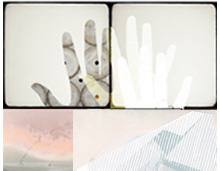A matter of perception
Hear that? See what I see? Researchers at Concordia’s new Centre for Sensory Studies (CSS) are discovering how social and cultural factors affect our perceptions.
"Take occupations," says David Howes, the centre’s director. "Musicians work at listening, while cooks are better at tasting.
“Whole cultures also specialize in different sensory registers, which become reflected in their beliefs, practices and language,” he adds. “In Western society, for example, with its emphasis on the visual presentation of information, we speak of the mind’s eye, whereas in many oral societies knowledge is held to reside in the ear.”

The CSS is made up of researchers and graduate students from all four of the university’s Faculties. Each new project involves a different constellation of disciplines, such as anthropology and design art, or history and marketing.
Three labs support the centre’s research mission. The Laboratory for Sensory Research at the John Molson School of Business carries out research on the sensory aspects of marketing. The Concordia Vision Laboratory, located within the Department of Psychology, conducts psychophysical experiments in human perception using state-of-the-art eye-tracking equipment. The studio-oriented labXmodal, which is also part of the Hexagram-Concordia Centre for Research-Creation in Media Arts and Technologies, is dedicated to creating and studying environments that immerse people in multisensory experiences.
The centre, which was officially recognized as a research facility by the Faculty of Arts and Science earlier this year, is already at the forefront of sensory studies because of its origins. The centre is derived from the Concordia Sensoria Research Team (CONSERT) formed in 1988 and internationally acclaimed for its ground-breaking work in the history, sociology and anthropology of the senses.
For example, Constance Classen, one of CONSERT’s original members, has just published her sixth book, titled The Deepest Sense: A Cultural History of Touch. In it, she explores how the past felt. There was a time, for instance, when people were encouraged to handle museum pieces. Then it was hands-off for most of the last century. Now curators are searching for ways to make exhibits interactive again.
One of the centre’s primary goals is to educate – even perfect – our senses. “We want to find out how to train our senses to derive ever greater knowledge and pleasure from them,” Howes explains. “Looking to other cultures and historical periods gives us a broader understanding of how the senses can be used.”
The research has many practical applications. Doctoral candidate Lois Frankel is investigating the use of sensors in clothing to help older people facing sensory decline to continue to live safely on their own. Psychology professor Aaron Johnson is using the vision lab to develop prosthetic devices that will assist individuals with sight impairments.
At the Laboratory for Sensory Research, a recent project explored the extent to which companies can alter their packaging without people noticing a product has been reduced in size.
By bringing many different disciplines to bear on the study of the senses and perception, the Centre is expanding the possibilities for each of our five senses.
Related links:
• "Four New Research Centres Established” — NOW, February 6, 2012
• Centre for Sensory Studies
• Sensory Studies
• “Studying History, with Feeling,” by Peter Monaghan, The Chronicle of Higher Education, June 18, 2012